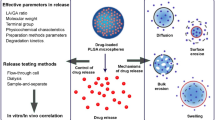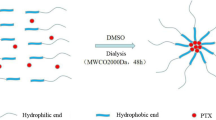Abstract
5-Fluorouracil (5FU) was successfully entrapped within poly(lactide-co-glycolide) (PLGA) and hydroyapatite (HA) composite microspheres using the emulsification/solvent extraction technique. The effects of HA to PLGA ratio, solvent ratio as well as polymer inherent viscosity (IV) on encapsulation efficiency were investigated. The degradation and drug release rates of the microspheres were studied for 5 weeks in vitro in phosphate buffered solution of pH 7.4 at 37 °C. The drug release profile followed a biphasic pattern with a small initial burst followed by a zero-order release for up to 35 days. The initial burst release decreased with increasing HA content. The potential of HA in limiting the initial burst release makes the incorporation of HA into PLGA microspheres advantageous since it reduces the risk of drug overdose from high initial bursts. The linear sustained drug release profile over the course of 5 weeks makes these 5-FU-loaded HA/PLGA composite microparticles a promising delivery system for the controlled release of chemotherapy drugs in the treatment of cancer.





Similar content being viewed by others
References
Kohn J, Abramson S, Langer R. Bioresorbable and bioerodible materials, Ratner BD, Hoffman AS, Schoen FJ, Lemons JE, editors. Biomaterials science, an introduction to materials in medicine. 2nd ed. Elsevier; 2004: p. 115–27.
Jain RA. The manufacturing techniques of various drug loaded biodegradable poly(lactide-co-glycolide) (PLGA) devices. Biomaterials. 2000;21:2475–90.
Heya T, Mikura Y, Nagai A, et al. Controlled release of thyrotropin releasing hormone from microspheres: evaluation of release profiles and pharmacokinetics after subcutaneous administration. J Pharm Sci. 1994;83:798–801.
Jeffery H, Davis SS, O’Hagan DT. The preparation and characterization of poly(lactide-co-glycoloide) microparticles. II. The entrapment of a model protein using a (water-in-oil)-in-water emulsion solvent evaporation technique. Pharm Res. 1993;10:362–8.
Uchida T, Martin S, Foster TP, et al. Dose and load studies for subcutaneous and oral delivery of poly(lactide-co-glycolide) microspheres containing ovalbumin. Pharm Res. 1994;11:1009–15.
Song CX, Labhasetwar V, Murphy H, et al. Formulation and characterization of biodegradable nanoparticles for intravascular local drug delivery. J Control Release. 1997;43:197–212.
Chen L, Apte RN, Cohen S. Characterization of PLGA microspheres for the controlled delivery of IL-1 for tumor immunotherapy. J Control Release. 1997;43:261–72.
Menei P, Daniel V, Montero-Menei C, Brouillard M, Pouplard-Barthelaix A, Benoit JP. Biodegradation and brain tissue reaction to poly(d,l-lactide-co-glycolide) microspheres. Biomaterials. 1993;14:470–8.
Geze A, Venier-Julienne MC, Saulnier P, Varlet P, Daumas-Duport C, Devauchelle P, Benoit JP. Modulated release of IdUrd from poly(d, l-lactide-co-glycolide) microspheres by addition of poly(d, l-lactide) oligomers. J Control Release. 1998;58:311–22.
Pean JM, Venier-Julienne MC, Boury F, Menei P, Denizot B, Benoit JP. NGF release from poly(d,l-lactide-co-glycolide) microspheres: effects of some formulation parameters on encapsulated NGF stability. J Control Release. 1998;56:175–87.
Boisdron-Celle M, Menei P, Benoit JP. Preparation and characterization of 5-fluorouracil-loaded microparticles as biodegradable anticancer drug carriers. J Pharm Pharmacol. 1995;47:108–14.
Menei P, Boisdron-Celle M, Croue A, Guy G, Benoit JP. Effect of stereotactic implantation of biodegradable 5-fluorouracil-loaded microspheres in healthy and C6 glioma-bearing rats. Neurosurgery. 1996;39:117–23.
Faisant N, Akiki J, Siepmann F, Benoit JP, Siepmann J. Effects of the type of release medium on drug release from PLGA-based microparticles: experiment and theory. Int J Pharm. 2006;314:189–97.
Freiberg S, Zhu X. Polymer microspheres for controlled drug release. Int J Pharm. 2004;282:1–18.
Langenbach RJ, Dancenberg PV, Heidelberger C. Thymidylate synthetase: mechanism of inhibition of 5-fluorouracil-2-deoxyuridylate. Biochem Biophys Res Commun. 1972;48:1565–71.
Yoshikawa R, Kusunoki M, Yanagi H, Noda M, Furuyama J, Yamamura T, Hashimoro-Tamaoki T. Dual antitumor effects of 5-fluorouracil on the cell cycle in colorectal carcinoma cells: a novel target mechanism concept for pharmacokinetic modulating chemotherapy. Cancer Res. 2001;61:1029–37.
Yu J, Zhang L, Hwang PM, Rago C, Kinzler KW, Vogelstein B. Identification and classification of p-53 regulated genes. Proc Natl Acad Sco USA. 1999;96:14517–22.
Diasio RB, Harris BE. Clinical pharmacology of 5-fluorouracil. Clin Pharmacokinet. 1989;16:215–37.
Kubo M, Kuwayama N, Hirashima Y, Takaku A, Ogawa T, Endo S. Hydroxyapatite ceramics as a particulate embolic material: report of the clinical experience. Am J Neuroradiol. 2003;24:1545–7.
Prakesh KH, Kumar R, Ooi CP, Cheang P, Khor KA. Apparent solubility of hydroxyapatite in aqueous medium and its influence on the morphology of nanocrystallites with precipitation temperature. Langmuir. 2006;22:11002–8.
Siepmann J, Faisant N, Akki J, Richard J, Benoit JP. Effect of the size of biodegradable microparticles on drug release: experiment and theory. J Control Release. 2004;96:123–34.
Siepmann J, Faisant N, Benoit JP. A new mathematical model quantifying drug release from bioerodible microparticles using Monte Carlo simulations. Pharm Res. 2002;19:1885–93.
Chen X, Ooi CP. Hydrolytic degradation and drug release properties of ganciclovir-loaded biodegradable microspheres. Acta Biomaterialia. 2008;4:1046–56.
Yang YY, Chia HH, Chung TS. Effect of preparation temperature on the characteristics and release profiles of PLGA microspheres containing protein fabricated by double-emulsion solvent extraction/evaporation method. J Control Release. 2000;69:81–96.
Li H, Chang J. pH-compensation effect of bioactive inorganic fillers on the degradation of PLGA. Compos Sci Technol. 2005;65:2226–32.
Author information
Authors and Affiliations
Corresponding author
Rights and permissions
About this article
Cite this article
Lin, Y., Li, Y. & Ooi, C.P. 5-Fluorouracil encapsulated HA/PLGA composite microspheres for cancer therapy. J Mater Sci: Mater Med 23, 2453–2460 (2012). https://doi.org/10.1007/s10856-012-4723-2
Received:
Accepted:
Published:
Issue Date:
DOI: https://doi.org/10.1007/s10856-012-4723-2




